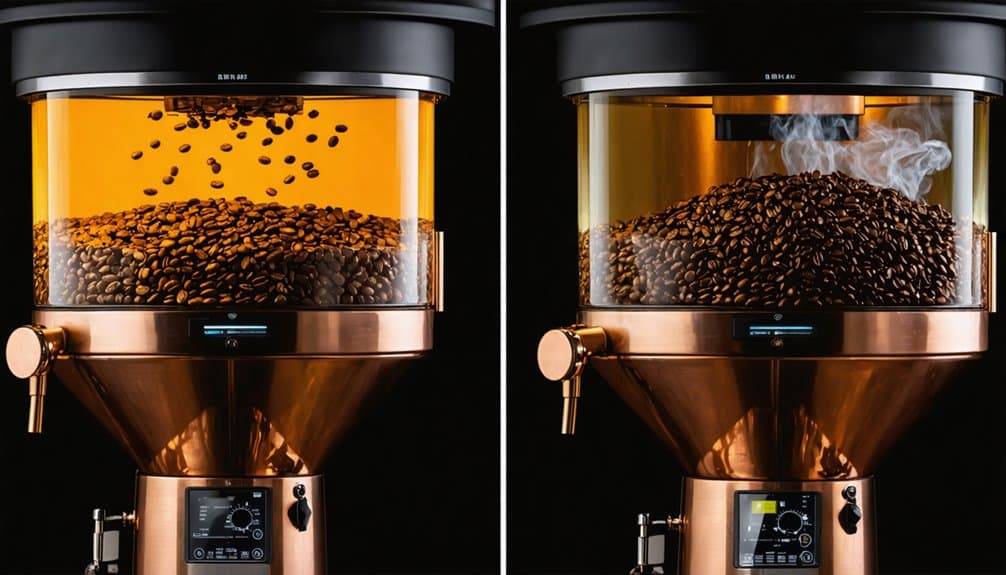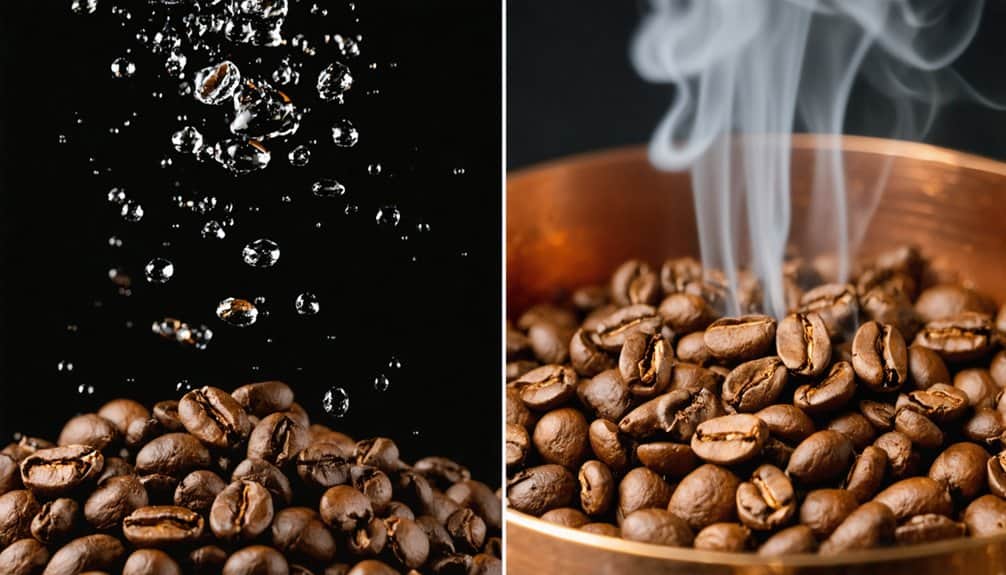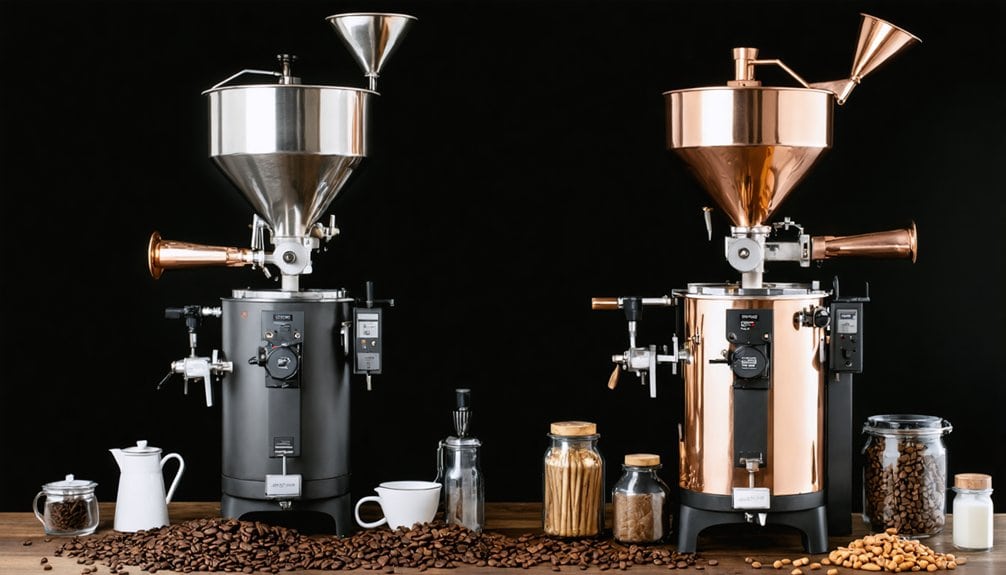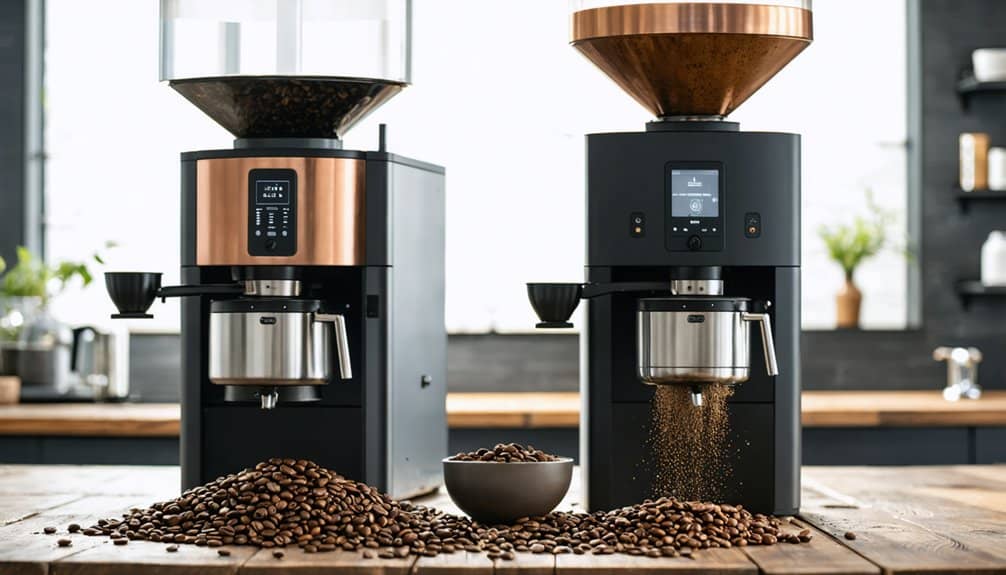Air roasting and drum roasting offer distinct advantages for your coffee production goals. You'll find air roasting delivers cleaner, brighter flavors through rapid convection heating (6-8 minutes), with superior precision and digital control. Drum roasting produces fuller-bodied flavors through longer mechanical mixing (15+ minutes), excelling at larger batch sizes. Your choice depends on desired flavor profiles, production volume, and equipment investment – factors that shape your coffee's ultimate character.
Key Takeaways
- Air roasting produces cleaner, brighter flavors with higher acidity, while drum roasting creates fuller-bodied, richer flavors with smoother notes.
- Air roasting takes 6-8 minutes with precise temperature control, whereas drum roasting requires 12-20 minutes with more variable results.
- Air roasters cost less and need minimal maintenance, while drum roasters are pricier but handle larger batch sizes efficiently.
- Drum roasting relies on mechanical turning and indirect heat, while air roasting uses hot air circulation for consistent temperature.
- Air roasting offers superior digital control and consistency, while drum roasting requires more expertise and subjective monitoring.
Understanding the Core Differences Between Air and Drum Roasting

When examining coffee roasting methods, the fundamental distinctions between air and drum roasting systems manifest in four key areas: temperature control, flavor development, processing time, and precision.
You'll find that air roasting delivers consistent temperatures through hot air circulation, resulting in clean, bright flavors and precise control. The process takes just 6-8 minutes, preserving delicate notes while efficiently separating chaff. Plus, burnt chaff residue negatively impacts the taste of drum-roasted coffee.
In contrast, drum roasting relies on mechanical turning and indirect heat, leading to longer roast times of 15+ minutes. While this creates full-bodied flavors, you'll encounter more temperature variations and less precise control over the final product.
The Science Behind Heat Transfer Methods
To master coffee roasting, you'll need to understand the three primary heat transfer methods: conduction, convection, and radiation. Each method plays a significant role in transforming your green beans into perfectly roasted coffee.
| Heat Method | Primary Application |
|---|---|
| Conduction | Direct contact with heated drum surface |
| Convection | Hot air circulation and bean agitation |
| Radiation | Electromagnetic heat penetration |
You'll find most professional roasters combine these methods for best results. Drum roasters typically utilize conduction and convection, while air roasters primarily rely on convection. High-quality roasters like Giesen offer flexible control settings to adjust between different heat transfer methods. Understanding these principles helps you control temperature progression and development of specific flavor profiles in your roasts.
Precision and Control in Air Roasting

You'll find air roasting's temperature monitoring systems provide exceptional precision through real-time data collection and analysis of bean temperature changes. The digital control features offer programmable parameters that let you fine-tune variables like airflow velocity, pressure, and heat intensity throughout the roasting cycle. These sophisticated controls enable you to create and replicate specific roast profiles with remarkable consistency, ensuring each batch meets your exact specifications. The hot air circulation method eliminates direct contact with heating surfaces, promoting more uniform roasting across all beans in the batch.
Temperature Monitoring Systems
Because precision is paramount in air roasting, modern temperature monitoring systems employ sophisticated technology to achieve exceptional control and consistency. You'll find systems like Chinook that sample temperatures 10 times per second, providing real-time data for immediate adjustments. The installation of a heat-resistant probe ensures accurate temperature readings during the roasting process.
Your roasting experience is improved through wireless monitoring systems that transmit data up to 500 feet indoors. These systems store up to 16,000 readings and display both graphical and numerical data. You can manage recipes effectively while receiving customizable alerts if temperatures deviate from your desired profile. Despite challenges like ambient conditions, advanced monitoring guarantees you'll maintain consistent results.
Digital Control Features
Modern air roasting systems incorporate advanced digital control features that improve precision beyond traditional temperature monitoring. You'll find sophisticated digital controls that enable one-button replication of ideal roast profiles, while advanced sensors provide real-time data for precise adjustments. These systems reduce cognitive load, letting you focus on crafting the perfect roast. Systems like the Kaffelogic Nano 7 allow real-time monitoring through dedicated software platforms.
- Digital modulating valves offer superior control for challenging profiles and variable batch sizes
- Automated processes track and replicate successful roast profiles with push-button ease
- Extensive data logging captures bean temp, environmental temp, and drum pressure metrics
With MODBUS communication tracking fuel, fan, and drum adjustments, you're equipped to make informed decisions and maintain consistency across batches.
Traditional Drum Roasting Characteristics
Traditional drum roasting stands as one of coffee's most established processing methods, utilizing a rotating cylinder over a heat source to transform green beans into roasted coffee. You'll find this method operates within temperatures of 355-480°F, where beans develop over three distinct phases: drying, browning, and final development.
The drum's rotation guarantees even heat distribution through a balance of conductive and convective transfer. You'll need to carefully monitor the drum's RPM – lower speeds optimize conductive heating but risk uneven roasts, while higher speeds increase convection but can cause scorching. This precise control defines your success in achieving consistent results. This artisanal approach typically processes small batch quantities up to 10 kg at a time.
Impact on Coffee Bean Flavor Profiles

You'll notice distinct differences in how flavors develop between air and drum roasting, with air roasting typically producing brighter, more pronounced origin characteristics in less time. When comparing origin-specific taste profiles, air roasting tends to highlight the natural acidity and floral notes of beans, while drum roasting emphasizes body and caramelized sweetness. The key distinction lies in how each method affects the final cup's acidity and body – air roasting preserves higher acidity with a lighter body, whereas drum roasting typically results in fuller body with moderated acidity levels. Because air roasting operates at lower temperatures between 400-450°F, it can better preserve the delicate flavors inherent to the beans.
Flavor Development Over Time
Understanding how coffee flavors develop over time requires examining the complex interplay between roasting techniques and chemical reactions. You'll notice distinct differences between air and drum roasting timelines, with air roasting's faster process preserving bright, acidic notes while drum roasting's slower approach improves sweetness through extended caramelization. The roasting process transforms green beans into rich coffee by developing 800 to 1000 compounds that create its distinctive aroma.
- Initial crack marks critical chemical changes, triggering Maillard reactions that create hundreds of flavor compounds
- Roast duration directly impacts acidity – longer times break down acidic compounds for smoother profiles
- Post-roast aging peaks between 6-23 days, after which flavors begin degrading rapidly
Origin Taste Vs Roasting
The interplay between origin taste and roasting method shapes the final expression of coffee beans' inherent characteristics. When you're choosing between air and drum roasting, you'll find that each method distinctly affects your beans' flavor profile.
Drum roasting, with its longer conduction heating process, mutes acidity while building body and sweetness. You'll notice it's particularly effective for dry-processed beans. Air roasting, through convection heating, preserves more origin flavors and acidity, making it ideal for wet-processed beans from regions like East Africa. Achieving optimal flavor development requires monitoring temperatures until the beans reach their first crack stage around 385°F.
Your choice between methods should align with your beans' natural characteristics and your desired flavor outcome.
Acidity and Body Differences
Coffee bean roasting methods create distinct variations in acidity and body profiles, with air and drum roasting producing markedly different results. You'll find air roasting preserves more natural acidity through quick heating, while drum roasting mutes acidic notes due to longer exposure times. The heat transfer by conduction in drum roasting contributes to its characteristic flavor development. When considering body characteristics, drum roasting excels at preserving fuller body through deeper caramelization, particularly beneficial for dry process beans.
- Air roasting: Brighter acidity, lighter body, improved fruity notes
- Drum roasting: Smoother acidity, richer body, pronounced caramelization
- Temperature impact: Higher temperatures in drum roasting develop body, while air roasting's precision maintains clarity
Time and Temperature Considerations
When roasting coffee beans, precise control of time and temperature variables markedly influences the final product's characteristics. You'll find air roasters complete the process in 6-7 minutes, while drum roasters take 15-30 minutes. Both methods operate between 180-250°C, with initial crack occurring at 200-202°C and second crack at 224-226°C. Roast masters carefully monitor these crucial temperature points to ensure optimal flavor development.
Air roasters utilize convection heat transfer, enabling faster roasting with higher temperatures without bean damage. Drum roasters combine conduction and convection, requiring longer roasting times at lower temperatures. You'll need to carefully monitor these parameters to achieve your desired roast profile and avoid common issues like scorching or tipping.
Equipment Cost and Maintenance Comparison

When comparing air and drum roasters, you'll find significant cost variations with air roasters ranging from $300-$3000 and drum roasters typically commanding higher prices but offering greater batch capacity and longevity. Your maintenance requirements will differ substantially, as air roasters need less intensive daily cleaning but more frequent part inspections, while drum roasters demand thorough cleaning routines and professional servicing to prevent fire hazards and maintain roasting consistency. Regular preventative maintenance schedules are crucial for both types of roasters to ensure optimal performance and equipment longevity. The long-term cost analysis must factor in both the initial investment and ongoing maintenance expenses, considering that drum roasters generally retain higher resale value despite their more complex maintenance needs.
Cost Breakdown Analysis
Understanding the cost dynamics between air and drum coffee roasters reveals three distinct market segments: entry-level, mid-range, and commercial grade equipment. You'll find air roasters dominate the entry-level segment ($100-$300), while drum roasters excel in commercial applications ($2,999-$59,500). Mid-range options for both types overlap notably ($500-$1,500). For budget-conscious enthusiasts, a stovetop popcorn popper provides an economical entry point into home coffee roasting.
- Entry-level air roasters offer the most affordable starting point at $100-$300
- Mid-range options from both categories compete directly, with prices ranging $500-$1,500
- Commercial drum roasters command premium prices but offer greater capacity and durability
Consider maintenance costs: air roasters typically require less upkeep due to fewer moving parts, while drum roasters need more frequent maintenance and costlier replacement parts.
Long-term Maintenance Requirements
Although both air and drum coffee roasters require consistent maintenance schedules, their long-term upkeep demands differ markedly in complexity and cost. You'll find air roasters generally need less intensive cleaning, though they still demand daily chaff removal and weekly vent inspections.
For drum roasters, you'll need to invest more time in maintenance due to their complex mechanical systems. Your daily routine must include thorough chaff collection and surface cleaning, while weekly checks should focus on drum alignment and residue buildup. Regular inspection of airflow helps prevent potential hazards and maintains roasting quality. In both cases, you'll want quarterly professional servicing to guarantee peak performance and extend your equipment's lifespan.
Origin Flavor Preservation Vs Roasting Notes
The distinct heat transfer mechanisms of air and drum roasting create fundamentally different approaches to preserving a coffee bean's origin characteristics. Air roasting's convective heat transfer completes in 6-8 minutes, preserving more original flavors and acidity, while drum roasting's 15-minute conductive process develops deeper caramelization and body-focused notes. PID-controlled air roasters offer precise temperature management for consistent results.
- Air roasting highlights fruity notes and clean acidity, ideal for wet-processed East African beans
- Drum roasting improves body and sweetness, perfect for dry-processed Brazilian and Indonesian varieties
- Chaff management affects final flavor: air roasting removes it cleanly, while drum roasting can incorporate smoky notes
Your choice between methods should align with your bean origin and desired flavor profile.
Consistency and Batch Quality Analysis

When comparing consistency between air and drum roasting methods, you'll find significant differences in their ability to produce reliable results. Air roasting provides superior temperature control and precise chaff removal, completing batches in 6-12 minutes while preserving original bean flavors. You'll achieve more consistent outcomes due to its automated precision. Fluid-bed roasters can manage larger batch sizes while maintaining fewer defects compared to traditional drum roasters.
Drum roasting, while traditional, faces consistency challenges. Its mechanical mixing and longer roasting times (12-20 minutes) can lead to variable results. Your batches may differ due to subjective color-based monitoring and chaff inclusion affecting flavor profiles. For ideal batch quality in either method, you'll need to maintain consistent batch sizes and rigorous quality control procedures.
Choosing the Right Method for Your Coffee Goals
Selecting between air and drum roasting methods requires a clear understanding of your desired coffee characteristics. If you're seeking bright, acidic notes with pronounced origin flavors, air roasting's quick process and precise temperature control will serve your goals. For those pursuing rich, complex profiles with deep caramelization, drum roasting's longer development time delivers ideal results. Hot air streams utilized in modern roasting methods provide exceptional consistency across batches.
- Air roasting: Choose for cleaner, brighter profiles and maximum origin flavor retention
- Drum roasting: Select for fuller body, deeper flavors, and pronounced Maillard reaction
- Consider your batch size requirements, as drum roasting typically handles larger quantities efficiently
FAQs
Which Roasting Method Produces Less Smoke and Is Better for Indoor Use?
You'll find air roasting produces considerably less smoke than drum roasting, making it your ideal choice for indoor use. It's more efficient with better chaff collection and faster roasting times.
Can You Switch Between Air and Drum Roasting Methods Mid-Process?
You can't switch roasting methods mid-process, as it'd disrupt the bean's development and require different equipment setups. It's like trying to change planes mid-flight – technically impossible and counterproductive.
How Long Do Roasted Beans Stay Fresh With Each Method?
You'll find air-roasted beans stay fresh for 7-14 days, while drum-roasted beans last up to 3 weeks. With proper storage techniques, you can extend freshness by refrigerating or freezing either type.
Which Method Is More Environmentally Friendly and Energy-Efficient?
To summarize, you'll find air roasting is more eco-friendly, using 50% less energy than drum roasting and reducing CO2 emissions by 25% through efficient heat recycling and afterburner elimination.
Are Certain Coffee Bean Varieties Better Suited for Specific Roasting Methods?
You'll find wet-processed beans from East Africa excel with air roasting, preserving their bright acidity, while dry-processed Indonesian and Indian beans develop richer body through drum roasting's gradual heat transfer.
The Bottom Line
Whether you're favoring air roasting's precise heat control or drum roasting's traditional convection approach, you'll need to align your method with your coffee objectives. Air roasting delivers clean, origin-forward profiles while drum roasting yields complex, developed flavors. Your choice should factor in batch consistency requirements, equipment investment parameters, and desired flavor outcomes. Consider your production scale and quality metrics when making this critical technical decision.
